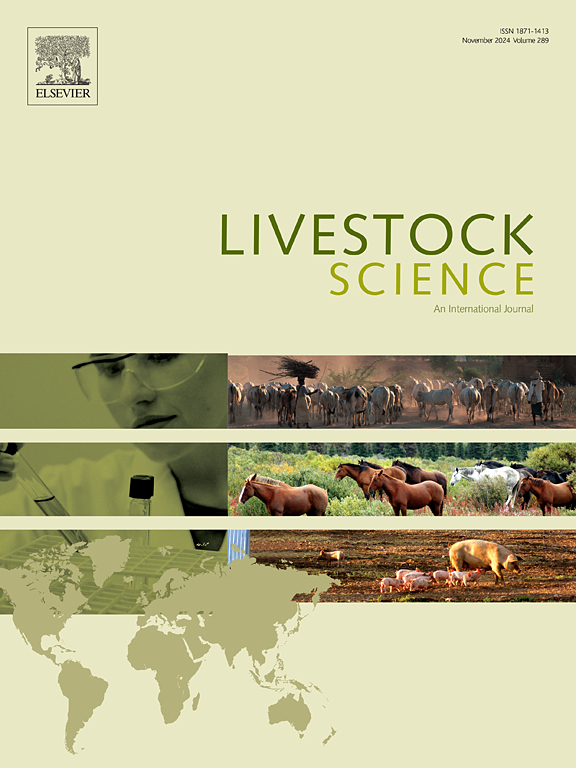妊娠后期多产母猪对日粮蛋白质的需求量
IF 1.8
3区 农林科学
Q2 AGRICULTURE, DAIRY & ANIMAL SCIENCE
引用次数: 0
摘要
本研究旨在确定妊娠后期多胎母猪对蛋白质的需求量。根据妊娠第 84 天的体重(BW;287 ± 5 kg)和胎次(3.8 ± 0.1),将 48 头多胎母猪分配到六种日粮处理中的一种,从妊娠第 84 天到 108 天每天饲喂 3.3 kg。五个日粮处理的日粮蛋白质浓度不断增加[以标准化回肠可消化(SID)赖氨酸(Lys)表示;3.05 至 6.90 g/kg]。第六种处理(高-cAA)相对于赖氨酸浓度降低了粗蛋白(CP),并补充了结晶氨基酸(AA),因此补充的 AA 浓度与每公斤含 6.90 克 SID 赖氨酸的日粮浓度一致,其余必需 AA 与每公斤含 3.05 克 SID 赖氨酸的日粮浓度一致。测量母猪体重和背膘厚度(BF),在妊娠期第 84、96 和 108 天采血,并在哺乳期每周采血一次。在妊娠期第 84 和 108 天以及哺乳期第 3 和 28 天注射氧化氘,以估计母猪的身体成分。妊娠期第 107 天进行氮(N)平衡。分娩开始时,对母猪的初乳和血液进行采样,记录活产和死产仔猪的数量和出生时间,以及活产仔猪的出生体重。产仔后 12、24 和 36 h 分别对仔猪进行称重和初乳采样,此后在哺乳期每周进行称重和乳汁采样。从妊娠第 84 天到 108 天,母猪的体重随 SID Lys 的增加而增加,直到 SID Lys 为 5.63 g/kg 时达到峰值(P = 0.02);母猪的繁殖力与 SID Lys 呈多项式关系,在 SID Lys 为 4.85 g/kg 时达到峰值(P = 0.04)。妊娠第 107 天,氮的保留率和利用率随 SID Lys 的增加而线性增加,并分别在 5.60 (P < 0.001) 和 5.07 g/kg SID Lys (P < 0.01) 达到高峰。日粮处理对繁殖参数没有影响,也没有迹象表明会对泌乳性能产生影响。在处理期间,与饲喂 3.05 g/kg SID Lys 的母猪相比,饲喂高 CAA 日粮的母猪体重(P < 0.01)和体蛋白(P = 0.02)增重更高;与饲喂 6.90 g/kg SID Lys 的母猪相比,妊娠第 107 天母猪尿液中尿素和氮的排泄量减少(两者的 P < 0.001)。此外,与其他任何处理相比,饲喂高 CAA 日粮的母猪血浆浓度在处理期间逐渐降低(P < 0.01),表明 AA 氧化减少。总之,妊娠期第 84 至 108 d 的 SID Lys 浓度为 4.85 至 5.07 g/kg(16.0 至 16.7 g/d),可确保高繁殖力母猪对 N 的最佳利用,并最大限度地提高 BF 增重。仔猪、窝产重和母猪产奶量不受日粮中 SID Lys 浓度的影响。给妊娠后期母猪饲喂相对于 Lys 降低了 CP 并补充了结晶 AA 的日粮,改善了 N 平衡,没有迹象表明繁殖和随后的泌乳性能受损或母猪增重降低,这表明高 CAA 日粮的 AA 组成符合母猪对必需 AA 的需求。本文章由计算机程序翻译,如有差异,请以英文原文为准。
Dietary protein requirement of hyper-prolific sows in late gestation
This study aimed to determine the protein requirement of hyper-prolific sows in late gestation. Forty-eight multiparous sows were assigned to one of six dietary treatments according to body weight (BW; 287 ± 5 kg) on d 84 of gestation and parity (3.8 ± 0.1) and fed 3.3 kg/d from d 84 to 108 of gestation. Five dietary treatments had increasing concentrations of dietary protein [expressed as standardized ileal digestible (SID) lysine (Lys); 3.05 to 6.90 g/kg]. The sixth treatment (high-cAA) had reduced crude protein (CP) relative to Lys concentration and was supplemented with crystalline amino acids (AA), so that the concentration of the supplemented AA matched that of the diet containing 6.90 g/kg of SID Lys and the remaining essential AA matched that of the diet containing 3.05 g/kg of SID Lys. Sow BW and backfat thickness (BF) were measured and blood was sampled on d 84, 96 and 108 of gestation and weekly during lactation. Deuterium oxide was injected on d 84 and 108 of gestation and on d 3 and 28 of lactation to estimate sow body composition. A nitrogen (N) balance was conducted on d 107 of gestation. At the onset of farrowing, colostrum and blood were sampled from the sows and number and birth time of live- and stillborn piglets, and birth weight of liveborn were recorded. Piglets were weighed and colostrum sampled at 12, 24, and 36 h after the onset of farrowing, and thereafter weekly weighing and milk sampling during lactation. From d 84 to 108 of gestation sow BW increased with SID Lys until reaching a plateau at 5.63 g/kg of SID Lys (P = 0.02) and sow BF had a polynomial relationship with SID Lys, which peaked at 4.85 g/kg of SID Lys (P = 0.04). On d 107 of gestation, N retention and utilization increased linearly with SID Lys and reached plateaus at 5.60 (P < 0.001) and 5.07 g/kg of SID Lys (P < 0.01), respectively. Reproductive parameters were not affected by dietary treatments and there were no indications of carry-over effects to lactational performance. During the treatment period, sows fed the high-cAA diet had higher BW (P < 0.01) and body protein (P = 0.02) gain than sows fed 3.05 g/kg of SID Lys and on d 107 of gestation they had reduced excretion of urea and N in urine (P < 0.001 for both) relative to sows fed 6.90 g/kg of SID Lys. Also, compared to any other treatment, the plasma concentration of sows fed the high-cAA diet gradually decreased during the treatment period (P < 0.01), indicating reduced AA oxidation. In conclusion, a SID Lys concentration of 4.85 to 5.07 g/kg (16.0 to 16.7 g/d) from d 84 to 108 of gestation ensures optimal utilization of N and maximizes BF gain in hyper-prolific sows. Piglet and litter birth weight and sow milk yield were unaffected by dietary concentration of SID Lys. Feeding late gestating sows diets with reduced CP relative to Lys and supplemented with crystalline AA, improved N balance, with no indications of impaired reproductive and subsequent lactational performance or reduced maternal gain, suggesting that the AA composition of the high-cAA diet met the sows’ requirement for essential AA.
求助全文
通过发布文献求助,成功后即可免费获取论文全文。
去求助
来源期刊

Livestock Science
农林科学-奶制品与动物科学
CiteScore
4.30
自引率
5.60%
发文量
237
审稿时长
3 months
期刊介绍:
Livestock Science promotes the sound development of the livestock sector by publishing original, peer-reviewed research and review articles covering all aspects of this broad field. The journal welcomes submissions on the avant-garde areas of animal genetics, breeding, growth, reproduction, nutrition, physiology, and behaviour in addition to genetic resources, welfare, ethics, health, management and production systems. The high-quality content of this journal reflects the truly international nature of this broad area of research.
 求助内容:
求助内容: 应助结果提醒方式:
应助结果提醒方式:


